NVIDIA’s GeForce GTX 480 and GTX 470: 6 Months Late, Was It Worth the Wait?
by Ryan Smith on March 26, 2010 7:00 PM EST- Posted in
- GPUs
Image Quality & AA
When it comes to image quality, the big news from NVIDIA for Fermi is what NVIDIA has done in terms of anti-aliasing of fake geometry such as billboards. For dealing with such fake geometry, Fermi has several new tricks.
The first is the ability to use coverage samples from CSAA to do additional sampling of billboards that allow Alpha To Coverage sampling to fake anti-alias the fake geometry. With the additional samples afforded by CSAA in this mode, the Fermi can generate additional transparency levels that allow the billboards to better blend in as properly anti-aliased geometry would.
The second change is a new CSAA mode: 32x. 32x is designed to go hand-in-hand with the CSAA Alpha To Coverage changes by generating an additional 8 coverage samples over 16xQ mode for a total of 32 samples and giving a total of 63 possible levels of transparency on fake geometry using Alpha To Coverage.
In practice these first two changes haven’t had the effect we were hoping for. Coming from CES we thought this would greatly improve NVIDIA’s ability to anti-alias fake geometry using cheap multisampling techniques, but apparently Age of Conan is really the only game that greatly benefits from this. The ultimate solution is for more developers of DX10+ applications to enable Alpha To Coverage so that anyone’s MSAA hardware can anti-alias their fake geometry, but we’re not there yet.
So it’s the third and final change that’s the most interesting. NVIDIA has added a new Transparency Supersampling (TrSS) mode for Fermi (ed: and GT240) that picks up where the old one left off. Their previous TrSS mode only worked on DX9 titles, which meant that users had few choices for anti-aliasing fake geometry under DX10 games. This new TrSS mode works under DX10, it’s as simple as that.
So why is this a big deal? Because a lot of DX10 games have bad aliasing of fake geometry, including some very popular ones. Under Crysis in DX10 mode for example you can’t currently anti-alias the foliage, and even brand-new games such as Battlefield: Bad Company 2 suffer from aliasing. NVIDIA’s new TrSS mode fixes all of this.

Bad Company 2 DX11 Without Transparency Supersampling
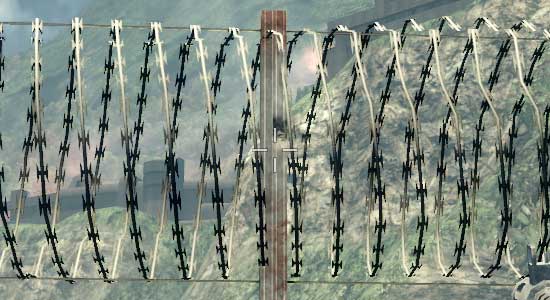
Bad Company 2 DX11 With Transparency Supersampling
The bad news is that it’s not quite complete. Oh as you’ll see in our screenshots it works, but the performance hit is severe. It’s currently super-sampling too much, resulting in massive performance drops. NVIDIA is telling us that this should be fixed next month, at which time the performance hit should be similar to that of the old TrSS mode under DX9. We’ve gone ahead and taken screenshots and benchmarks of the current implementation, but keep in mind that performance should be greatly improving next month.
So with that said, let’s look at the screenshots.

| NVIDIA GeForce GTX 480 | NVIDIA GeForce GTX 285 | ATI Radeon HD 5870 | ATI Radeon HD 4890 |
| 0x | 0x | 0x | 0x |
| 2x | 2x | 2x | 2x |
| 4x | 4x | 4x | 4x |
| 8xQ | 8xQ | 8x | 8x |
| 16xQ | 16xQ | DX9: 4x | DX9: 4x |
| 32x | DX9: 4x | DX9: 4x + AAA | DX9: 4x + AAA |
| 4x + TrSS 4x | DX9: 4x + TrSS | DX9: 4x + SSAA | |
| DX9: 4x | |||
| DX9: 4x + TrSS |
With the exception of NVIDIA’s new TrSS mode, very little has changed. Under DX10 all of the cards produce a very similar image. Furthermore once you reach 4x MSAA, each card producing a near-perfect image. NVIDIA’s new TrSS mode is the only standout for DX10.
We’ve also include a few DX9 shots, although we are in the process of moving away from DX9. This allows us to showcase NVIDIA’s old TrSS mode, along with AMD’s Adapative AA and Super-Sample AA modes. Note how both TrSS and AAA do a solid job of anti-aliasing the foliage, which makes it all the more a shame that they haven’t been available under DX10.
When it comes to performance, keep in mind that both AMD and NVIDIA have been trying to improve their 8x MSAA performance. When we reviewed the Radeon 5870 back in September we found that AMD’s 8x MSAA performance was virtually unchanged, and 6 months later that still holds true. The performance hit moving from 4x MSAA to 8x MSAA on both Radeon cards is roughly 13%. NVIDIA on the other hand took a stiffer penalty under DX10 for the GTX 285, where there it fell by 25%. But now with NVIDIA’s 8x MSAA performance improvements for Fermi, that gap has been closed. The performance penalty for moving to 8x MSAA over 4x MSAA is only 12%, putting it right up there with the Radeon cards in this respect. With the GTX 480, NVIDIA can now do 8x MSAA for as cheap as AMD has been able to
Meanwhile we can see the significant performance hit on the GTX 480 for enabling the new TrSS mode under DX10. If NVIDIA really can improve the performance of this mode to near-DX9 levels, then they are going to have a very interesting AA option on their hands.
Last but not least, there’s anisotropic filtering quality. With the Radeon 5870 we saw AMD implement true angle-independent AF and we’ve been wondering whether we would see this from NVIDIA. The answer is no: NVIDIA’s AF quality remains unchanged from the GTX200 series. In this case that’s not necessarily a bad thing; NVIDIA already had great AF even if it was angle-dependant. More to the point, we have yet to find a game where the difference between AMD and NVIDIA’s AF modes have been noticeable; so technically AMD’s AF modes are better, but it’s not enough that it makes a practical difference
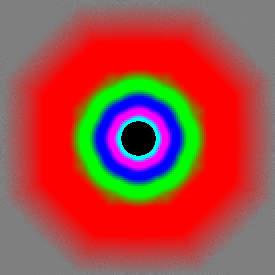
GeForce GTX 480

GeForce GTX 285
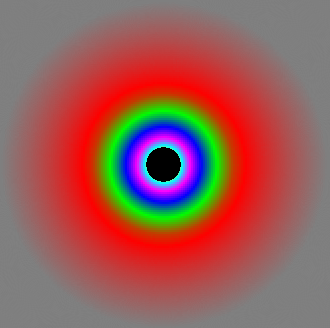
Radeon 5870


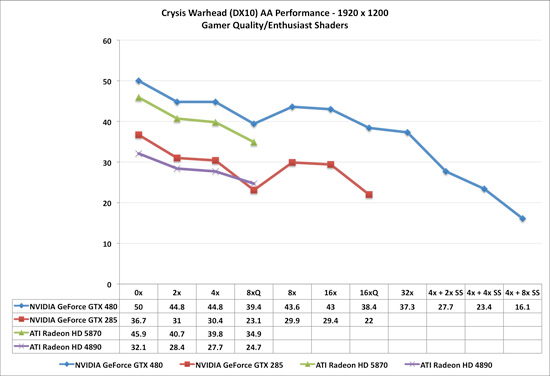
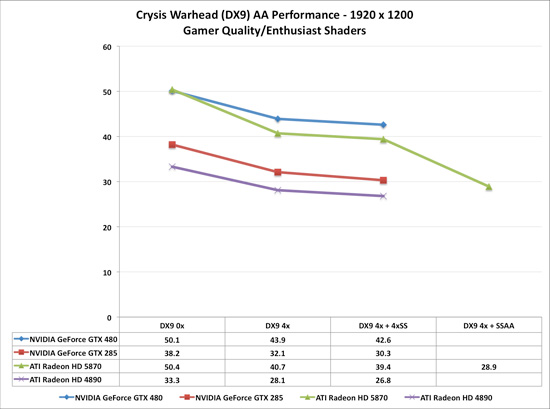








196 Comments
View All Comments
Ryan Smith - Saturday, March 27, 2010 - link
Yes, we did. We were running really close to the limits of our 850W Corsair unit. We measured the 480SLI at 900W, which after some power efficiency math comes out to around 750-800W actual load. At that load there's less extra space than we'd like to have.Just to add to that, we had originally been looking for a larger PSU after talking about PSU requirements with an NVNDIA partner, as the timing of this required we secure a new PSU before the cards arrived. So Antec had already shipped us their 1200W PSU before we could test the 850W, and we're glad since we would have been cutting it so close.
bigboxes - Sunday, March 28, 2010 - link
Appreciate the reply.GullLars - Saturday, March 27, 2010 - link
OK, so 480 generally beats 5870, and 470 generally beats 5850, but at higher prices, temperatures, wattage, and noise levels. What about 5970?As far as i can tell, the 5970 beat or came even with 480 in all tests, draws less power, runs cooler, and makes less noise. The price isn't that much more either.
It seems more fair to me to compare 480 with 5970 as both are the fastest single-card (as in PCIe slot) sollutions and are close in price and wattage.
I would also like to see what framerate FPS games come in at with gamer settings (1680x1050 and 1920x1200 resolutions), and if average is higher than game cutoff or tickrate, what is the minimum FPS, and how much can you bump eyecandy before avg drops below cutoff/tickrate or minimum drops below acceptable (30).
The reason for gamers sacraficing visuals to get high FPS can be summarized to game flow and latency. If FPS is below game tickrate, you get latency. For many games the tickrate is around 100 (100 updates in the game engine pr second). At 100 FPS you have 10ms latency between frames, if it drops to 50 you have 20 ms, and at 25 you have 40 ms. Lower than 25-30 FPS will obviously also result in virtually unplayable performance since aiming will becoming hard, so added latency from FPS below this becomes moot. If you are playing multiplayer games, this is added to the network latency. As most gamers know, latency below 30ms is generally desired, and above 50ms starts to matter, and above 100ms is very noticable. If you are on a bad connection (or have a bad connection to the server), 20-30ms added latency starts to matter even if it isn't visually notable.
bigboxes - Saturday, March 27, 2010 - link
Anyone else getting that message? I finally had to turn off the 'attack site' option in FF. It wasn't doing this last night. It's not doing it all over AT, just on the GTX 480 article.GullLars - Saturday, March 27, 2010 - link
Here too, it listed among others googleanalytics.com as a hostile site.It was probebly because NVidia wasn't happy with the review XD
(just joking ofc)
chrisinedmonton - Saturday, March 27, 2010 - link
Great article. Here's a small suggestion; temperature graphs should be normalised to room temperature rather than to 0C.GourdFreeMan - Sunday, March 28, 2010 - link
I agree. Temperature graphs should either be normalized to the ambient environment or absolute zero; any other choice of basis is completely arbitrary.Ahmed0 - Saturday, March 27, 2010 - link
Uh oh, my browser just got a heartwarming warning when I clicked on this article, the warning said that it might infect my computer badly and that I should definitely run home faster than my legs can carry.So, whats up with that?
Lifted - Saturday, March 27, 2010 - link
I just got that too. Had to disable the feature in Firefox.NJoy - Saturday, March 27, 2010 - link
well, Charlie was semi-accurate, but quite right =))What a hot chick... I mean, literately hot. Way too hot